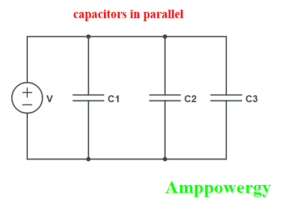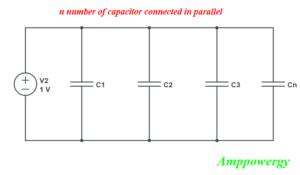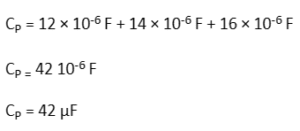capacitors in parallel Connection
What is Mean by a Capacitor
(capacitor in parallel Connection)
Capacitor is one of the important components in the three electronic components which make up the fundamentals of electrical circuits. The other two components are the resistor and inductor. Capacitor is a passive device that stores electrical charge in the form of electric fields. When voltage is supplied to it holds electrical charge and discharge itself when the circuit needs electrical charge.
Capacitors are constructed from parallel plates which are called metallic plates, and these plates are separated from each other with dielectric medium. When voltage is applied to the capacitor the positive terminal is charged positively and the negative terminal is charged negatively.
What is Mean by a Capacitance
(capacitors in parallel connection)
Voltage or potential difference is caused due to the charge accumulation on the plates of the capacitor. The amount of charge accumulated in the capacitor produces electrical voltage. The capacitance is the property of charge holding capacity of the capacitor. The capability of the capacitor is measured in capacitance. The capacitance is referred to as the charge stored in the capacitor to produce 1 volt of potential difference.
Due to the direct relationship between charge and voltage in the capacitor. So, the charge and voltage are directly proportional to each other’s.
Q∝V
Q = CV
Q is charge and V is voltage
C is constant
C=εA/d
Here A is the area of plates, d is the distance between plates and E is the permeability.
Classification of the capacitors
Capacitor are classified according to structure.
- Fixed capacitor
- Variable capacitor
- Trimmer capacitor
According to polarization capacitor are classified in two types.
- Polarized
- Unpolarized
What are Polarized capacitors
Polarized capacitor is an important component used in electrical circuits. Polarized capacitors are used to attain high capacitive density. This capacitor is known as electrolytic capacitor. These capacitors have specific positive and negative values. To use these capacitors in the circuit it is very important to know the correct polarity.
It is used in the industries for many applications. Polarized capacitors are used to gain more capacitance by utilizing electrolyte that is why it is called electrolyte capacitor. Electrolyte is simply a liquid with many ions. In electrolytic capacitor the voltage of positive terminal will always be higher than the negative terminal.
What are Non polarized capacitors
Non polarity capacitor is a type of capacitor which does not have positive and negative polarity means not polarized. These capacitors can be used in pure AC circuit because they do not destroy by reverse voltage, therefore it is preferred on polarized capacitors. This capacitor is also used in DC circuits due to absence of polarity. The frequency of non-polarized capacitor is high and low leakage current.
Capacitors in parallel Connection
Capacitors can be connected in two types which are parallel and series. In series the capacitors are connected one after the another like a chain, the capacitance will less in series.
If the capacitor is connected between two common points or if they are connected the positive side connected to positive and the negative side is connected to the negative the connection will be parallel.
In parallel connection the capacitance is high because the size of the plate is double in parallel connection.
Formula for capacitor in parallel
How capacitor works in parallel
Let’s take an example of the above circuit diagram.
In the above circuit diagram, there are three capacitors C1, C2, C3 connected in parallel. Now if voltage is applied to the circuit the current will start flowing from the positive terminal. voltage will be equal on each capacitor but the charge on each capacitor will be different due to the parallel connection.
The charge distribution in capacitor C1, C2, C3 will be Q1, Q2, Q3. Now capacitor has two plate one plate of the capacitor will have charge +Q and the other plate of the capacitor will have the charge –Q.
Now due to law of conservation of charge
Now from equation 1 and 2
Now to take V common in Equation 3
Now divide both side by “V” we get.
Here Cp means equivalent capacitance in parallel connection.
Now consider n number of capacitor are connected in parallel then the equation will be.
Let’s solve problem on the capacitor in parallel connection.
Example on Capacitors in Parallel Connection
Example 1
There are three capacitors C1 = 12 µF, C2 = 14 µF, and C3 = 16 µF connected in parallel in a circuit. The supply voltage is 220 V.
Solution:
So
Now to find equivalent capacitance use the above formula.
Example 2
There are two condensers whose capacitance is 5 µF and 10 µF and the supply voltage is 12 V and 24 V. what is the common potential when the connection is parallel.
Solution
Now find equivalent capacitance
Now if V is common potential, then
Advantage of capacitors in parallel Connection
- In parallel connection more energy will be stored as compared to series connection.
- In capacitor bank, the voltage balance is better between the capacitor bundle when capacitors are connected in parallel.
- It cost friendly because a smaller number of balancing resistors will be needed as compared to series connection.
Disadvantages of capacitors in parallel Connection
- It stores more energy, but it is unsafe to use in industries.
- As we know capacitor in parallel stores more energy while it releases that energy too. So, it is very dangerous for electrical wiring and for workers.
- In capacitors bank if one capacitor suddenly gets damaged then the remaining capacitor will draw total bus power and it can create heavy danger and may damage all capacitor bank.
- In series connection if one capacitor fails the other will remain unaffected.
Application of Capacitors in Parallel Connection
Capacitors have different application in parallel connection.
- DC power supplies: it is used to remove the ripples in AC and to filter signals.
- Power factor correction: capacitor banks are used to correct power factor in inductive load.
- Regenerative braking: capacitor bank is used for regenerative braking in automotive industries includes cars and other large vehicles.
- Increase capacitance: it is added in parallel to increase the total capacitance.
Frequently asked question FAQs
Q 1: more energy store when capacitors are in parallel, why?
Ans: because in parallel connection the total capacitance is the sum of individual capacitance.
Q2: how are capacitors connected in parallel?
Ans: capacitor is connected in parallel in way that the positive terminal will connect to the positive and the negative terminal will connect to the negative terminal.
Q3: how to find the total capacitance of capacitor in parallel connection?
Ans: the total capacitance of the capacitor in parallel connection Is the sum of the individual capacitance.
Q4: what is the rule for parallel capacitor?
Ans: the role as follows, the voltage will be equal in parallel connection and the total capacitance will be the sum of the individual capacitance.
Q5: why capacitor is connected in parallel.
Ans: The capacitors are connected in parallel to increase the increase the total capacitance. This is very helpful in different applications.
Q6: what is the factor that affects the capacitance in parallel circuit?
Ans: the factors that affect the capacitor in parallel circuit are the capacitance of each capacitor and how they are connected in the circuit.
Q7: is charge constant in parallel connection of capacitor?
Ans: yes, the charge is constant.
Q8: what will happen if the charge on a parallel plate capacitor is double?
Ans: if the charge is double on capacitor, then the capacitance will be same while the electric field will be double.
See Also:





1 thought on “Capacitors in Parallel Connection, its Advantages and Disadvantages”